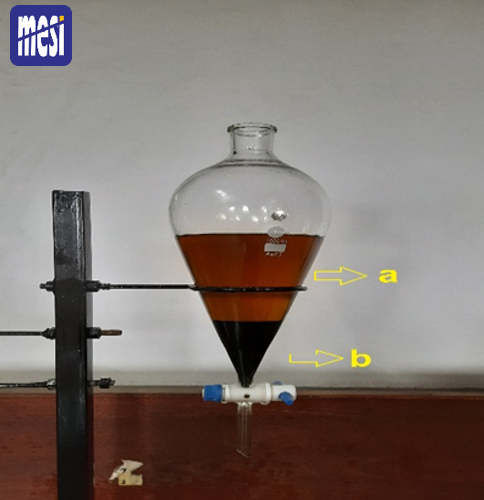Biodiesel Production from Waste Cooking Oil: Characterization, Modeling and Optimization
Main Article Content
Abstract
In this study, waste and discarded cooking oils (WCO) of palm, sunflower, rice bran and groundnut oils are collected from local restaurants. The high viscous WCO was converted into waste cooking oil biodiesel (WCOBD) by a single-stage transesterification process. During the transesterification process, the important parameters which show a significant change in biodiesel yield are studied using the optimization tool of response surface methodology (RSM). Results reported that 91.30% biodiesel yield was achieved within L18 experiments and NaOH catalyst was identified as the most influential parameter on WCOBD yield. Artificial Intelligence (AI) based modeling was also carried out to predict biodiesel yield. From AI modeling, a predicted yield of 92.88% was achieved, which is 1.70% higher than the RSM method. These results reveal the prediction capabilities and accuracy of the chosen modeling and optimization methods. In addition, the significant fuel properties are measured and observed within the scope of ASTM standards (ASTMD6751) and fatty acid profiles from chromatography reveal the presence of high unsaturated fatty acids in WCOBD. Therefore, utilizing the waste cooking oils for biodiesel production can mitigate the global challenges of environmental and energy paucity.
Downloads
Article Details

This work is licensed under a Creative Commons Attribution-NonCommercial 4.0 International License.
References
[2] V. R. Nalule, “Managing the decline of fossil fuels in the UK: lessons for developing countries,” Journal of Mines, Metals and Fuels, vol. 68, no. 4, pp. 131–135, 2021, doi: 10.18311/jmmf/2020/27643.
[3] T. Kivevele, T. Raja, V. Pirouzfar, B. Waluyo, and M. Setiyo, “LPG-Fueled Vehicles: An Overview of Technology and Market Trend,” Automotive Experiences, Apr. 2020, doi: 10.31603/ae.v3i1.3334.
[4] A. P. Saravanan, T. Mathimani, G. Deviram, K. Rajendran, and A. Pugazhendhi, “Biofuel policy in India: A review of policy barriers in sustainable marketing of biofuel,” Journal of Cleaner Production, vol. 193, pp. 734–747, 2018, doi: 10.1016/j.jclepro.2018.05.033.
[5] V. S. Narwane, V. S. Yadav, R. D. Raut, B. E. Narkhede, and B. B. Gardas, “Sustainable development challenges of the biofuel industry in India based on integrated MCDM approach,” Renewable Energy, vol. 164, pp. 298–309, 2021, doi: 10.1016/j.renene.2020.09.077.
[6] H. Shokravi et al., “Fourth generation biofuel from genetically modified algal biomass: Challenges and future directions,” Chemosphere, p. 131535, 2021, doi: 10.1016/j.chemosphere.2021.131535.
[7] S. Jain and M. P. Sharma, “Prospects of biodiesel from Jatropha in India: A review,” Renewable and Sustainable Energy Reviews, vol. 14, no. 2, pp. 763–771, 2010, doi: 10.1016/j.rser.2009.10.005.
[8] H. Fukuda, A. Kondo, and H. Noda, “Biodiesel fuel production by transesterification of oils,” Journal of bioscience and bioengineering, vol. 92, no. 5, pp. 405–416, 2001, doi: 10.1016/S1389-1723(01)80288-7.
[9] S. Rezania et al., “Review on transesterification of non-edible sources for biodiesel production with a focus on economic aspects, fuel properties and by-product applications,” Energy Conversion and Management, vol. 201, no. July, p. 112155, 2019, doi: 10.1016/j.enconman.2019.112155.
[10] D. Ayu, R. Aulyana, E. W. Astuti, K. Kusmiyati, and N. Hidayati, “Catalytic Transesterification of Used Cooking Oil to Biodiesel: Effect of Oil-Methanol Molar Ratio and Reaction Time,” Automotive Experiences, vol. 2, no. 3, pp. 73–77, 2019, doi: 10.31603/ae.v2i3.2991.
[11] S. Satya, A. Kolakoti, and R. Rao, “Optimization of palm methyl ester and its effect on fatty acid compositions and cetane number,” Mathematical Models in Engineering, vol. 5, no. 1, pp. 25–34, 2019, doi: 10.21595/mme.2019.20469.
[12] A. Gnanaprakasam, V. M. Sivakumar, A. Surendhar, M. Thirumarimurugan, and T. Kannadasan, “Recent strategy of biodiesel production from waste cooking oil and process influencing parameters: a review,” Journal of Energy, vol. 2013, 2013, doi: 10.1155/2013/926392.
[13] Z. Abdmouleh, A. Gastli, L. Ben-Brahim, M. Haouari, and N. A. Al-Emadi, “Review of optimization techniques applied for the integration of distributed generation from renewable energy sources,” Renewable Energy, vol. 113, pp. 266–280, 2017, doi: 10.1016/j.renene.2017.05.087.
[14] Y. Sewsynker-Sukai, F. Faloye, and E. B. G. Kana, “Artificial neural networks: an efficient tool for modelling and optimization of biofuel production (a mini review),” Biotechnology & Biotechnological Equipment, vol. 31, no. 2, pp. 221–235, 2017, doi: 10.1080/13102818.2016.1269616.
[15] A. Kolakoti and G. Satish, “Biodiesel production from low-grade oil using heterogeneous catalyst: an optimisation and ANN modelling,” Australian Journal of Mechanical Engineering, pp. 1–13, 2020, doi: 10.1080/14484846.2020.1842298.
[16] O. S. Valente, V. M. D. Pasa, C. R. P. Belchior, and J. R. Sodré, “Physical–chemical properties of waste cooking oil biodiesel and castor oil biodiesel blends,” Fuel, vol. 90, no. 4, pp. 1700–1702, 2011, doi: 10.1016/j.fuel.2010.10.045.
[17] M. Anwar, M. G. Rasul, N. Ashwath, and M. M. Rahman, “Optimisation of second-generation biodiesel production from Australian native stone fruit oil using response surface method,” Energies, vol. 11, no. 10, p. 2566, 2018, doi: 10.3390/en11102566.
[18] S. Puhan, N. Saravanan, G. Nagarajan, and N. Vedaraman, “Effect of biodiesel unsaturated fatty acid on combustion characteristics of a DI compression ignition engine,” Biomass and Bioenergy, vol. 34, no. 8, pp. 1079–1088, 2010, doi: 10.1016/j.biombioe.2010.02.017.
[19] V. Talamala, P. R. Kancherla, V. A. R. Basava, and A. Kolakoti, “Experimental investigation on combustion, emissions, performance and cylinder vibration analysis of an IDI engine with RBME along with isopropanol as an additive,” Biofuels, vol. 8, no. 3, pp. 307–321, 2017, doi: 10.1080/17597269.2016.1226723.
[20] A. Kolakoti, “An experimental based artificial neural network modeling in prediction of optimum combustion, performance, and emission from diesel engine operated with three biodiesels,” World Journal of Engineering, 2021, doi: 10.1108/WJE-01-2021-0010.

